Birds of prey, also known as raptors, are a fascinating group of predatory birds that are highly adapted for hunting and capturing their prey.
These majestic creatures display incredible aerial skills, powerful talons, and keen eyesight, making them top predators in the ecosystem.
In the state of Illinois, a varied range of raptors can be found, inhabiting diverse habitats such as woodlands, forests, grasslands, and wetlands.
This introduction will explore the different species of birds of prey that call Illinois their home, highlighting their characteristics, behavior, and the crucial role they play in maintaining the ecosystem’s balance.
1. Red-tailed Hawk
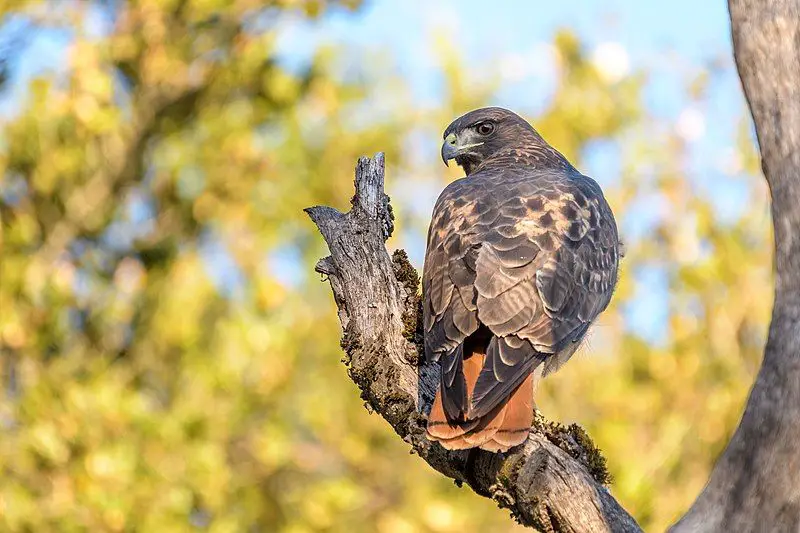
The red-tailed hawk is a type of bird known as a bird of prey. It is found in many different parts of North America. It breeds in a wide range of locations, from the interior of Alaska and northern Canada down to Panama and the West Indies.
This means that you can find red-tailed hawks in many different places throughout North America. The red-tailed hawk belongs to a group of birds called the genus Buteo. This genus includes many different species of hawks.
However, the red-tailed hawk is one of the most common members of this group, both in North America and worldwide.
This means that you are likely to come across a red-tailed hawk more often than other types of hawks within the Buteo genus. The red-tailed hawk is known for its distinctive red tail, which is where it gets its name from.
This feature helps to distinguish it from other types of hawks. However, it is important to note that not all red-tailed hawks have red tails.
Juvenile red-tailed hawks have brown tails, which only turn red as they mature. Red-tailed hawks are known for their impressive hunting skills. As birds of prey, they primarily.
| Kingdom | Animalia |
| Phylum | Chordata |
| Clade | Dinosauria |
| Class | Aves |
| Order | Accipitriformes |
| Family | Accipitridae |
| Genus | Buteo |
| Species | B. jamaicensis |
2. Red-shouldered Hawk
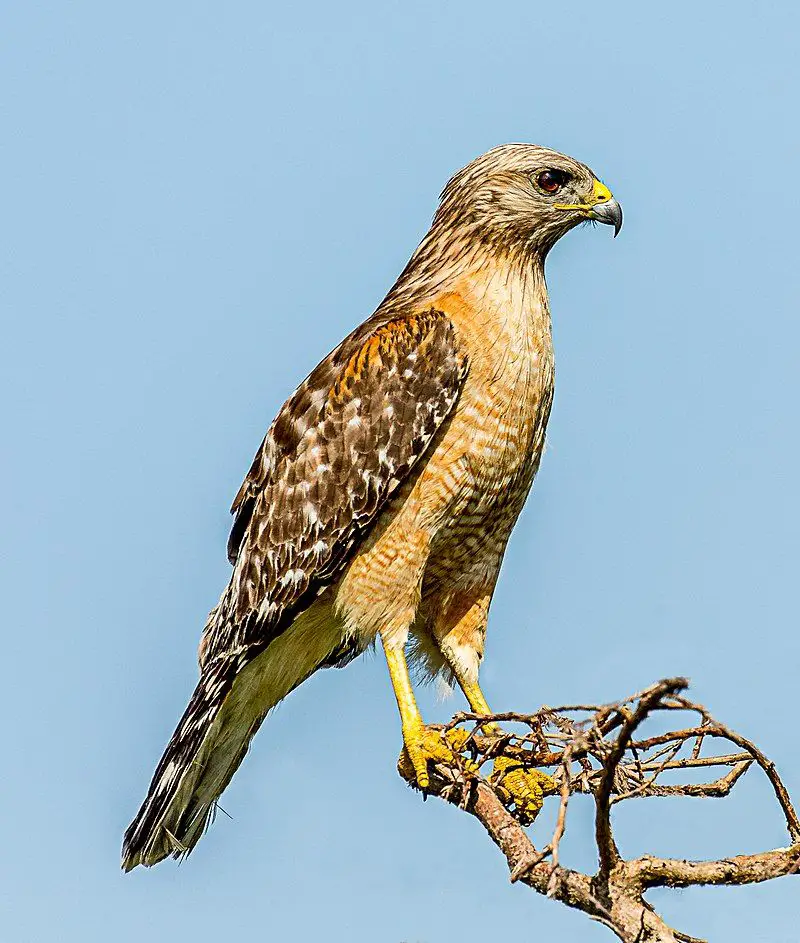
The red-shouldered hawk is a type of bird known as a medium-sized buteo. It can be found in various parts of North America, specifically in the eastern region, along the California coast, and in northern to northeastern-central Mexico.
This bird species is not a migratory one, as it is a permanent resident in most of its range. It chooses to stay in these areas year-round. However, there are some red-shouldered hawks in the northern parts of its range that do migrate.
They typically travel to central Mexico during their migration. The red-shouldered hawk is often seen in forests and woodlands, where it builds its nests and hunts for food. It prefers these types of habitats due to the availability of prey and suitable nesting sites.
These hawks have adapted to living in these environments and have become well-suited to their surroundings. As a medium-sized buteo, the red-shouldered hawk has certain characteristics that distinguish it from other birds.
Its size is not too large nor too small, making it a medium-sized bird. This allows it to have a good balance between agility and strength, which aids in its hunting and survival. One notable feature of the red-shouldered hawk is its red.
| Kingdom | Animalia |
| Phylum | Chordata |
| Class | Aves |
| Order | Accipitriformes |
| Family | Accipitridae |
| Genus | Buteo |
| Species | B. lineatus |
3. Cooper’s Hawk
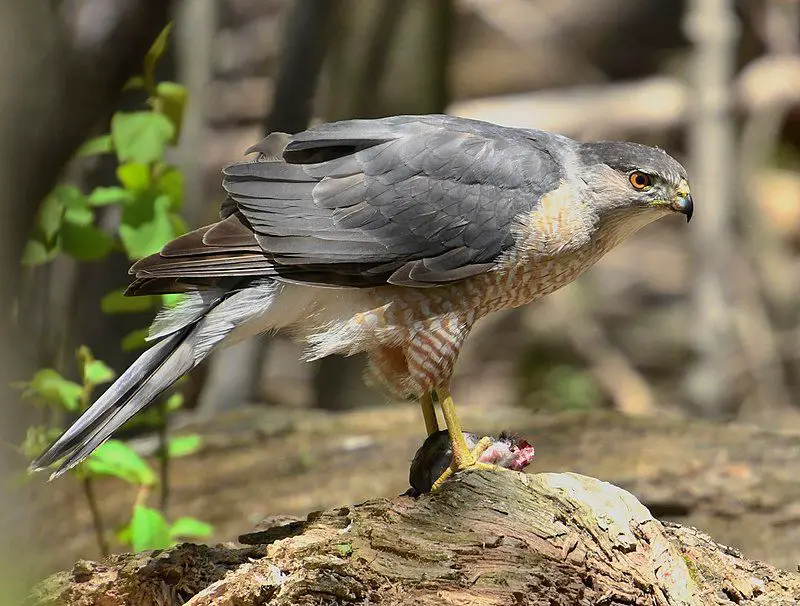
The Cooper’s hawk is a type of hawk that can be found in North America. It is considered to be a medium-sized bird.
This species is native to the continent and is commonly found in various regions ranging from southern Canada down to Mexico. One interesting characteristic of the Cooper’s hawk is its size.
It falls into the category of medium-sized hawks, which means it is neither too big nor too small. This size allows the hawk to adapt and survive in different habitats across North America. The distribution of the Cooper’s hawk is quite extensive.
It can be found in different parts of North America, including southern Canada, the United States, and Mexico.
This wide range of habitats gives the hawk ample opportunities to thrive and establish its presence in various ecosystems. Despite its widespread distribution, the Cooper’s hawk is not evenly distributed throughout its range.
It tends to be more common in certain areas while being less abundant in others. This variation in population density might be influenced by factors such as the availability of prey, nesting sites, and overall habitat suitability. The Cooper’s hawk is known for its hunting skills.
It primarily feeds on small to medium-sized birds, which it catches by surprise using its speed and agility. This hawk is well-adapted.
| Kingdom | Animalia |
| Phylum | Chordata |
| Class | Aves |
| Order | Accipitriformes |
| Family | Accipitridae |
| Genus | Accipiter |
| Species | A. cooperii |
4. Sharp-shinned Hawk
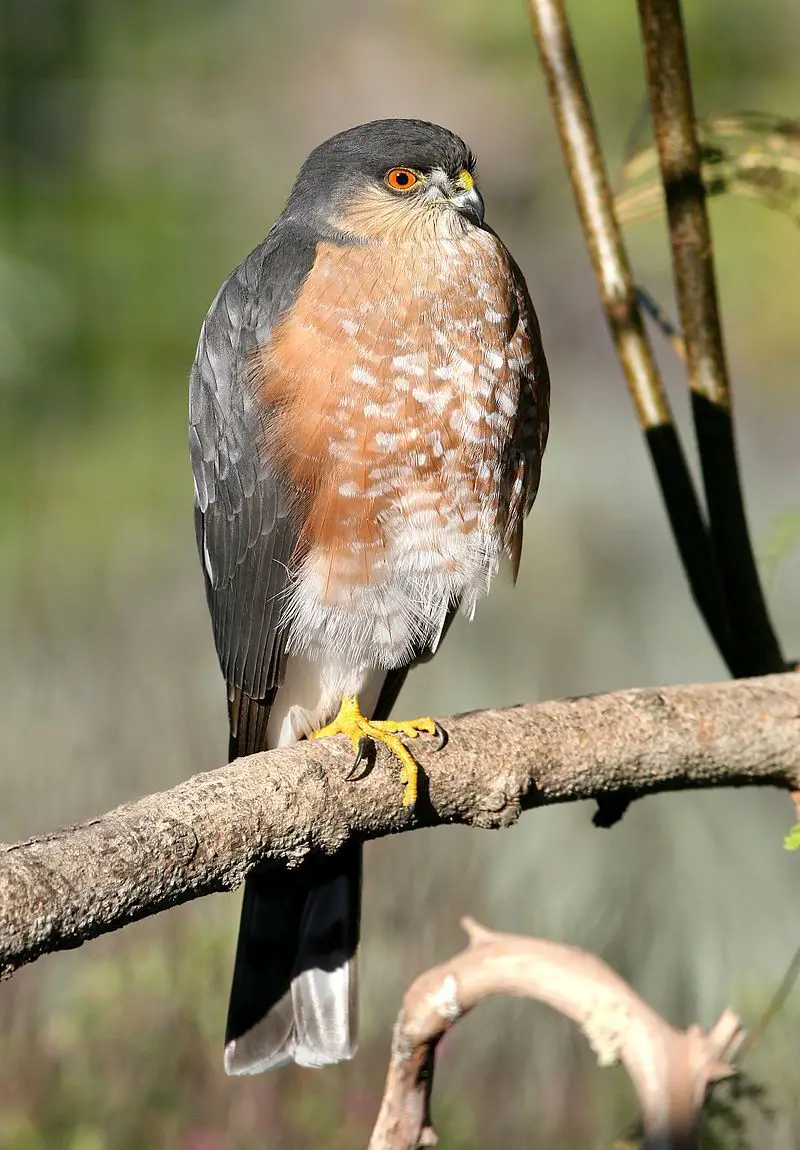
The sharp-shinned hawk, also known as a sharpie, is a small type of hawk. The males of this species are the smallest hawks found in both the United States and Canada.
However, it’s worth noting that the sharp-shinned hawk is still larger than certain Neotropical species, such as the tiny hawk. This particular species of hawk is commonly referred to as a sharpie due to its sharp features and small size.
Although it is small in comparison to other hawks, it is important to understand that it is still larger than certain types of hawks found in the Neotropics, which is a region of the Americas encompassing Central and South America.
The sharp-shinned hawk’s size is noteworthy because it is the smallest hawk species found in both the United States and Canada.
This means that when compared to other hawks that inhabit these regions, the sharp-shinned hawk stands out for its diminutive size.
Furthermore, it is interesting to consider that despite being small in the context of North American hawks, the sharp-shinned hawk is still larger on average than some Neotropical species, such as the tiny hawk.
This suggests that while the sharp-shinned hawk may be small relative to.
| Kingdom | Animalia |
| Phylum | Chordata |
| Class | Aves |
| Order | Accipitriformes |
| Family | Accipitridae |
| Genus | Accipiter |
| Species | A. striatus |
5. American Kestrel
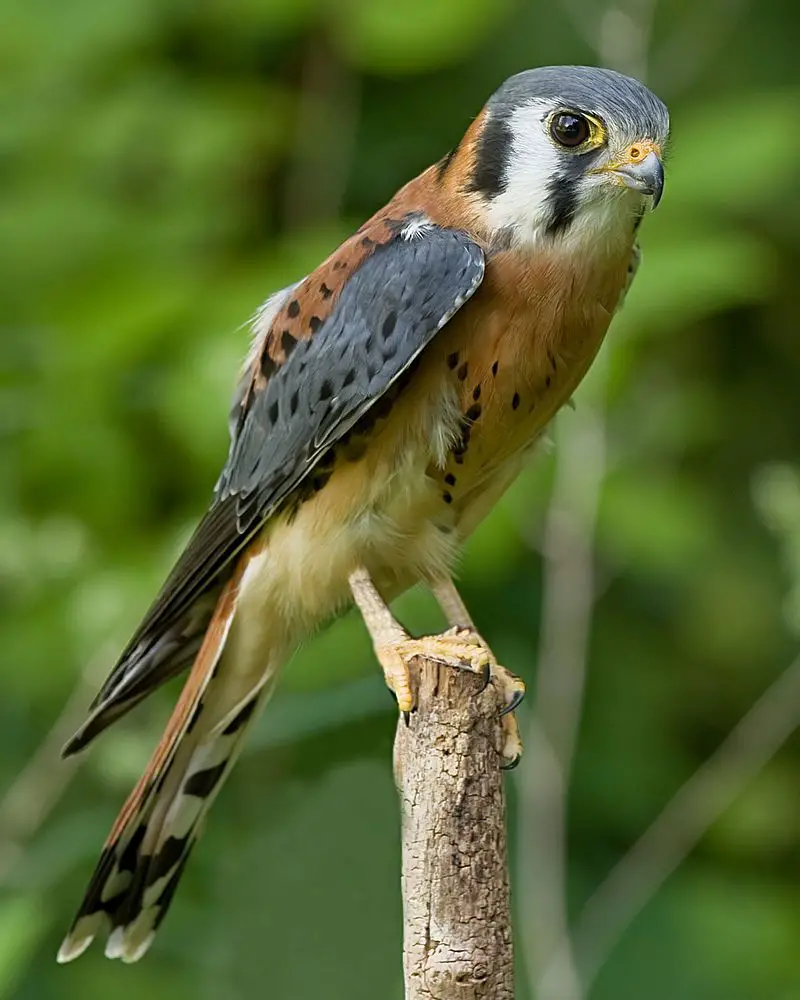
The American kestrel is a type of falcon that can also be known as the sparrow hawk. It is found in North America and is the smallest and most common falcon in the region. The size of the American kestrel can vary depending on the subspecies and the sex of the bird.
Generally, there is a two-to-one range in size between different individuals. When it comes to size, the American kestrel can range from being as small as a blue jay to as large as a mourning dove.
This means that some individuals can weigh as much as a blue jay, while others can be as heavy as a mourning dove. The variation in size within the American kestrel population can be attributed to differences in subspecies and also between males and females.
This means that females may generally be larger than males, and different subspecies may have different average sizes. It is interesting to note that despite this size variation, the American kestrel remains the smallest falcon in North America.
This indicates that even the largest individuals of this species are still relatively small compared to other falcons found in the region. In conclusion, the American kestrel, is also known as the sparrow.
| Kingdom | Animalia |
| Phylum | Chordata |
| Class | Aves |
| Order | Falconiformes |
| Family | Falconidae |
| Genus | Falco |
| Species | F. sparverius |
6. Broad-winged Hawk
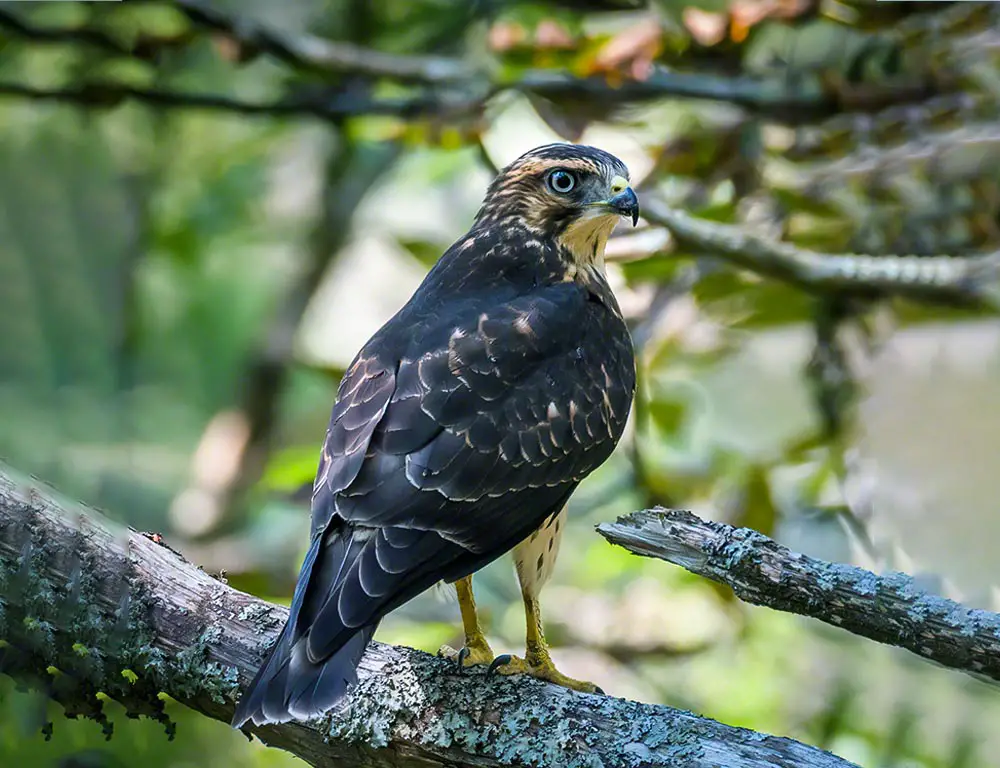
The broad-winged hawk is a type of hawk that is medium in size. It belongs to the genus Buteo. Some subspecies of this hawk are found in eastern North America during the summer. These subspecies can be found as far west as British Columbia and Texas.
However, when the winter season arrives, these hawks migrate to the Neotropics. The Neotropics is a region that extends from Mexico to southern Brazil. During the summer, the broad-winged hawk can be seen in various parts of eastern North America.
This includes areas as far west as British Columbia and Texas. These hawks prefer to reside in this region during the warmer months. They build their nests and raise their young in these areas.
However, when the temperature starts to drop and the winter season approaches, the broad-winged hawks begin their migration. They leave their summer homes in eastern North America and travel towards the Neotropics.
The Neotropics provide a more suitable environment for them during the colder months. The migration of these hawks takes them on a long journey. They fly southwards from their breeding grounds, crossing vast distances.
They travel through different regions, adapting to changing landscapes and weather conditions.
| Kingdom | Animalia |
| Phylum | Chordata |
| Class | Aves |
| Order | Accipitriformes |
| Family | Accipitridae |
| Genus | Buteo |
| Species | B. platypterus |
7. Rough-legged Buzzard
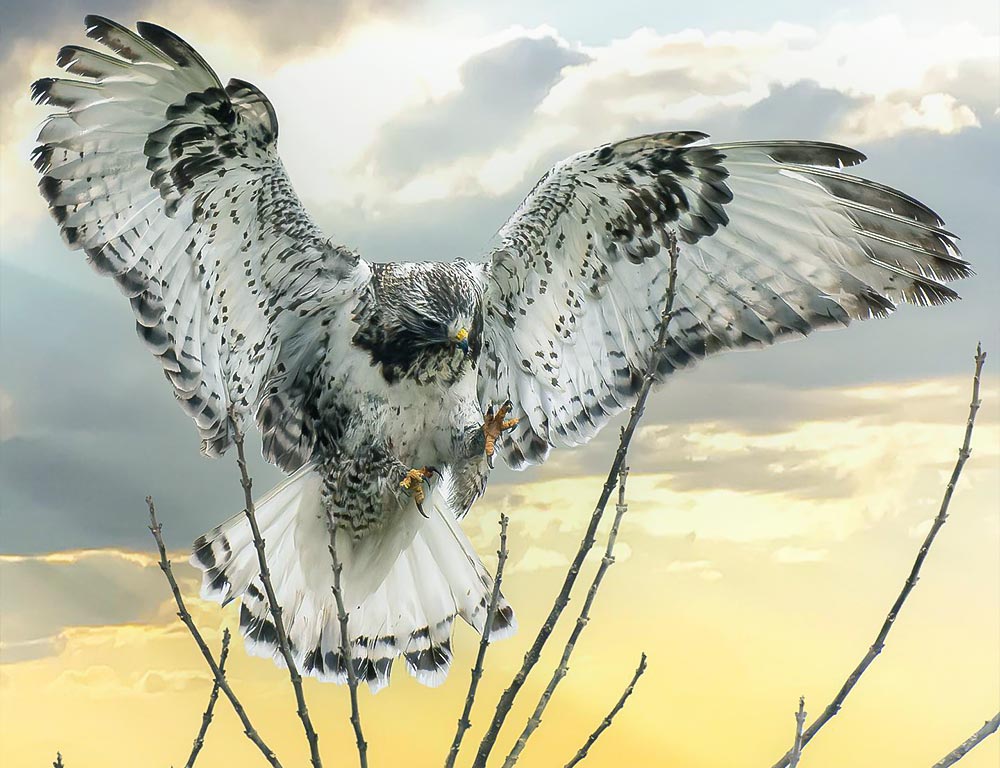
The rough-legged buzzard, also known as the rough-legged hawk, is a bird of prey that is medium-large in size. It can be found in the Arctic and Subarctic regions of North America, Europe, and Russia. During the breeding season, these buzzards make their home in these regions.
However, when winter arrives, they migrate south. These birds are well-suited to survive in the harsh Arctic and Subarctic climates. They have adapted to the cold weather and snowy landscapes of these regions.
The rough-legged buzzard has several physical characteristics that help it thrive in these environments. One of the distinctive features of the rough-legged buzzard is its feathered legs.
These feathers extend down to its feet, providing insulation against the cold temperatures.
This adaptation allows the bird to maintain its body heat and prevents frostbite. The rough-legged buzzard also has a large wingspan, which helps it soar through the air effortlessly. This enables the bird to cover long distances during migration and efficiently search for prey.
Their wings are broad and rounded, making them well-suited for gliding and hovering. When it comes to hunting, the rough-legged buzzard primarily feeds on small mammals, such as rodents. It has.
| Kingdom | Animalia |
| Phylum | Chordata |
| Class | Aves |
| Order | Accipitriformes |
| Family | Accipitridae |
| Genus | Buteo |
| Species | B. lagopus |
8. Peregrine Falcon
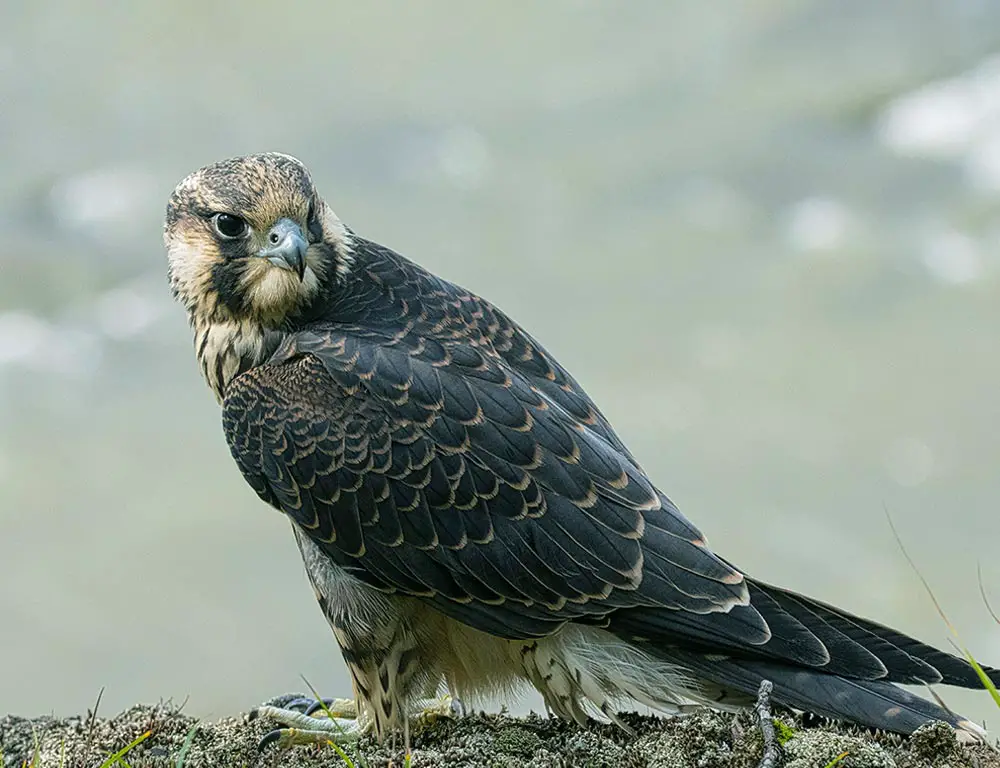
The peregrine falcon is a type of bird of prey that is found all around the world. It is also sometimes called the peregrine or the duck hawk in North America. The peregrine falcon belongs to the Falconidae family. One characteristic of the peregrine falcon is its size.
It is quite large, similar to the size of a crow. This falcon has a blue-grey color on its back, with white underparts that are marked with bars. Its head is black. The peregrine falcon is particularly famous for its speed.
It is known to be one of the fastest birds in the world. This falcon can fly at incredibly high speeds when it is hunting for its prey. Its swift flying ability is truly remarkable. Being a bird of prey, the peregrine falcon hunts and feeds on other animals.
It primarily preys on birds, catching them mid-air during flight. This falcon has sharp talons that help it catch and hold onto its prey.
Its hunting technique is both impressive and efficient. The peregrine falcon is a cosmopolitan bird, meaning it can be found in various parts of the world. It.
| Kingdom | Animalia |
| Phylum | Chordata |
| Class | Aves |
| Order | Falconiformes |
| Family | Falconidae |
| Genus | Falco |
| Species | F. peregrinus |
9. Bald Eagle

The bald eagle is a type of bird that lives in North America. It is considered a bird of prey, which means it hunts and feeds on other animals. This majestic bird is also known as a sea eagle. There are two known subspecies of the bald eagle.
Subspecies are variations of a species that have slightly different characteristics but can still interbreed. These subspecies of the bald eagle might have some differences in appearance or behavior. The bald eagle is closely related to another bird called the white-tailed eagle.
These two birds form a species pair, which means they are similar and occupy similar ecological niches.
The white-tailed eagle is found in the Palearctic region, which includes Europe, Asia, and Africa. Occupying the same niche means that both the bald eagle and the white-tailed eagle have similar roles in their respective ecosystems.
They both have adaptations that help them survive and thrive in their environments.
They might compete for similar food sources or have similar hunting strategies. In the Palearctic region, where the white-tailed eagle is found, it fulfills a similar ecological role as the bald eagle does in North America.
This means that both species have evolved to fill a specific niche or role in their habitats.
| Kingdom | Animalia |
| Phylum | Chordata |
| Class | Aves |
| Order | Accipitriformes |
| Family | Accipitridae |
| Genus | Haliaeetus |
| Species | H. leucocephalus |
10. Swainson’s Hawk
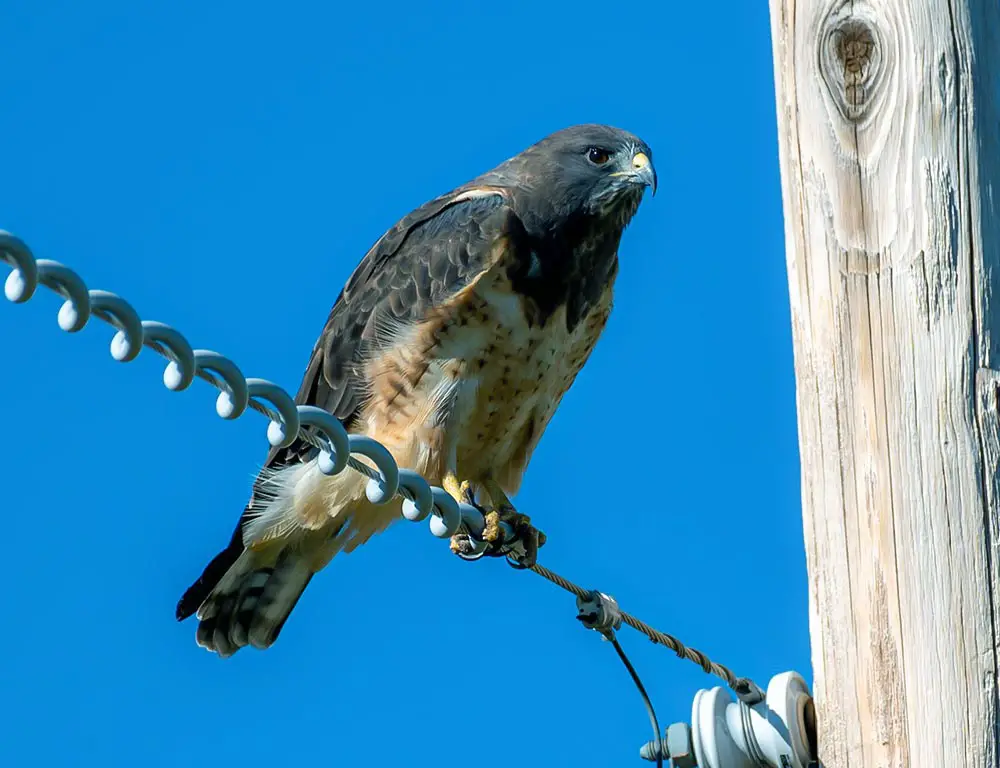
Swainson’s hawk is a type of bird that belongs to the Accipitriformes order. This means that it is classified along with other hawks, eagles, and vultures.
It is a relatively large bird species, known for its impressive size and strength. The name “Swainson’s hawk” comes from William Swainson, a British naturalist who played a significant role in studying and documenting various species of birds.
He was particularly interested in birds of prey, and this hawk species was named after him to honor his contributions to the field of ornithology. In addition to its scientific name, Swainson’s hawk is also known by a couple of colloquial names – the grasshopper hawk and the locust hawk.
These names reflect the hawk’s feeding habits and preferences. The bird is especially fond of a type of insect called Acrididae, which includes grasshoppers and locusts. When given the opportunity, Swainson’s hawks will voraciously eat these insects.
This means that they will consume them eagerly and in large quantities. This behavior is likely because Acrididae insects are abundant in the hawk’s natural habitat, providing a readily.
| Kingdom | Animalia |
| Phylum | Chordata |
| Class | Aves |
| Order | Accipitriformes |
| Family | Accipitridae |
| Genus | Buteo |
| Species | B. swainsoni |
11. Northern Goshawk

The Eurasian goshawk is a bird of prey that belongs to the Accipitridae family. This family includes other diurnal raptors like eagles, buzzards, and harriers.
The goshawk is classified as a medium-large bird, which means it is not too small or too big. Being a member of the genus Accipiter, the goshawk is often referred to as a “true hawk.”
This classification distinguishes it from other types of hawks that may have different characteristics or behaviors. As a diurnal bird of prey, the goshawk is active during the day, unlike nocturnal birds that hunt at night.
This means the goshawk relies on its keen eyesight and powerful talons to catch its prey during daylight hours. The goshawk can be found in Eurasia, which is a vast region encompassing Europe and Asia.
It inhabits various types of habitats, including forests, woodlands, and open areas. This adaptability allows the goshawk to thrive in different environments and find suitable prey.In terms of appearance, the goshawk has a distinctive look.
It has a robust body, broad wings, and a long tail. These physical traits enable.
| Kingdom | Animalia |
| Phylum | Chordata |
| Class | Aves |
| Order | Accipitriformes |
| Family | Accipitridae |
| Genus | Accipiter |
| Species | A. gentilis |
12. Golden Eagle
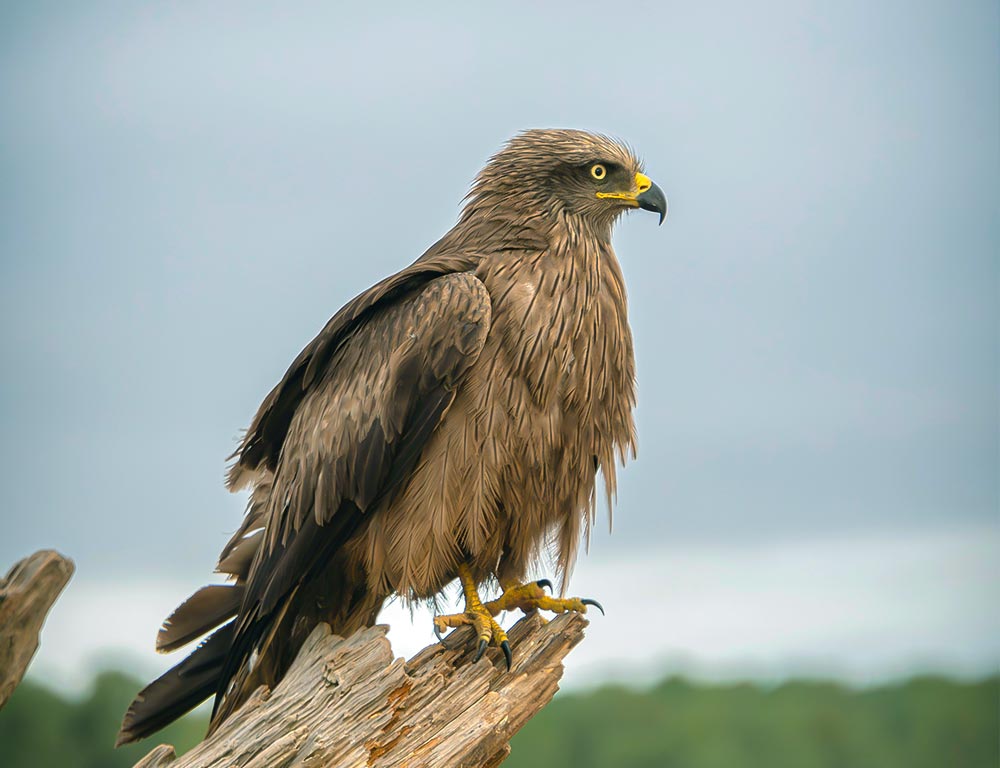
The golden eagle is a majestic bird that can be found in the Northern Hemisphere. It is known for its impressive hunting skills and powerful presence in the sky.
Being the most widely distributed species of eagle, it can be seen across various regions around the world. Belonging to the family Accipitridae, the golden eagle shares its lineage with other eagles and birds of prey.
This family includes a diverse range of species that share common characteristics and hunting techniques. One of the reasons why the golden eagle is so well-known is its status as a formidable bird of prey in the Northern Hemisphere.
Its impressive size, sharp beak, and powerful talons make it a fearsome predator.
It is capable of taking down prey that is larger than itself, demonstrating its remarkable strength and agility. The golden eagle’s habitat spans a wide range of landscapes, including mountains, forests, and open grasslands.
They are highly adaptable and can thrive in various environments, from arid deserts to snowy mountain peaks.
Their adaptability contributes to their wide distribution and ability to survive in different climates. These birds have a striking appearance, with their golden-brown feathers and impressive wingspan. Their wings can span up to 7.5 feet.
| Kingdom | Animalia |
| Phylum | Chordata |
| Class | Aves |
| Order | Accipitriformes |
| Family | Accipitridae |
| Genus | Aquila |
| Species | A. chrysaetos |
13. Osprey
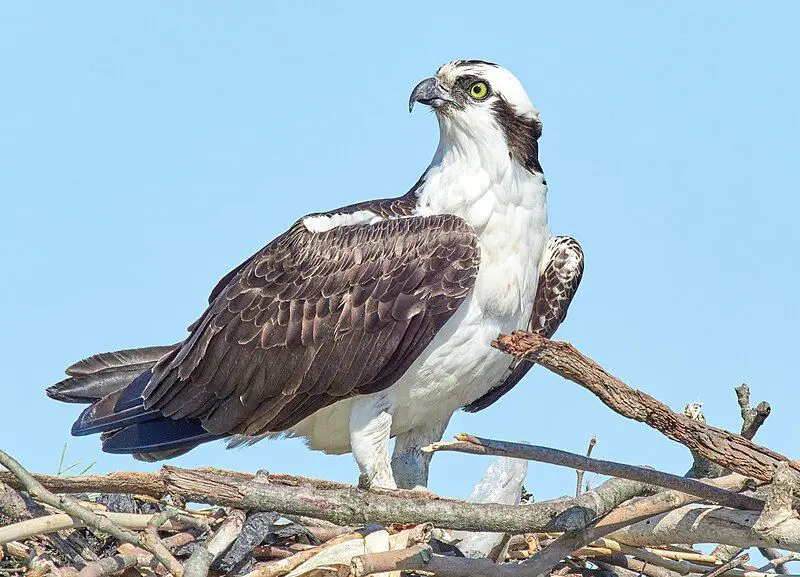
The osprey is a type of bird that is also known by different names such as sea hawk, river hawk, and fish hawk. It is a bird of prey that hunts and eats fish, and it is active during the daytime, which means it is diurnal.
The osprey can be found in various parts of the world, as it has a cosmopolitan range. In terms of size, the osprey is considered to be a large bird. It can grow to be more than 60 cm long, and its wingspan can reach up to 180 cm.
This makes it quite impressive when it takes flight and soars through the sky. In terms of appearance, the osprey has distinct coloring. The upper parts of its body are brown, which helps it blend in with its surroundings when perched on trees or other structures.
However, its head and underparts are predominantly greyish. This coloring may provide some camouflage when the osprey is near bodies of water, where it hunts for fish. Overall, the osprey is a fascinating bird with unique characteristics.
Its ability to hunt fish, its large size, and its distinct coloring make it a remarkable species to observe in its natural habitat.
| Kingdom | Animalia |
| Phylum | Chordata |
| Class | Aves |
| Order | Accipitriformes |
| Family | Pandionidae |
| Genus | Pandion |
| Species | P. haliaetus |
14. Prairie Falcon
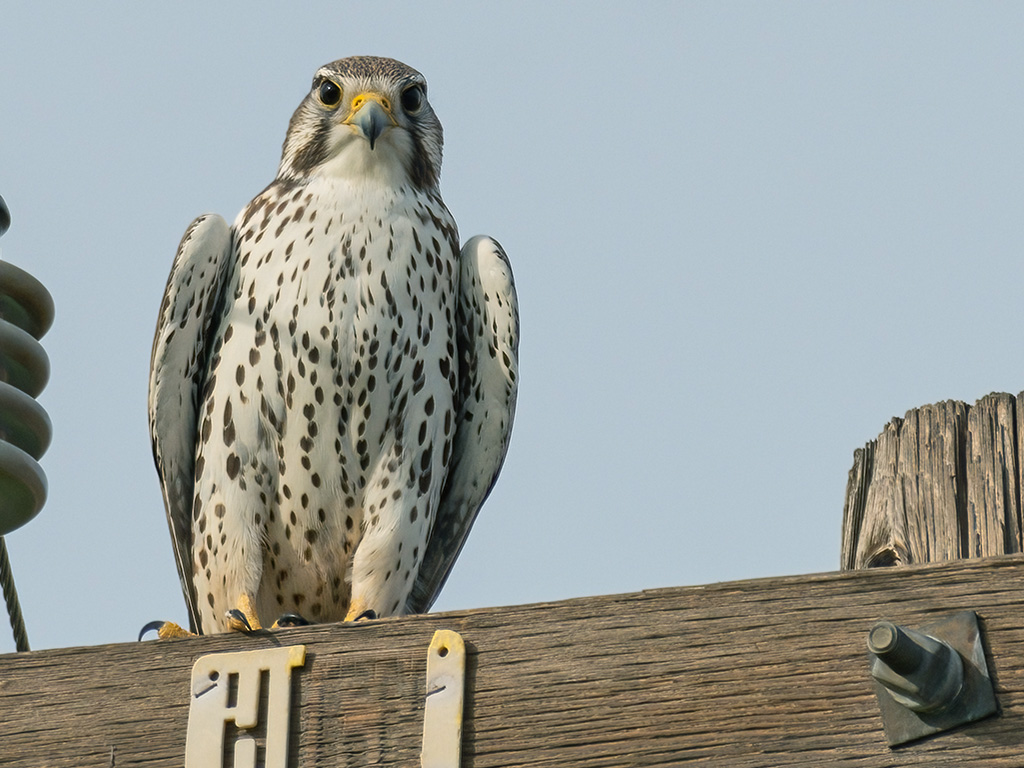
The prairie falcon is a type of falcon found in western North America. It is not too small or too big, but rather a medium-large sized bird. Its size can be compared to that of a peregrine falcon or a crow. In terms of length, the average prairie falcon measures around 40 cm.
This measurement gives us an idea of how long their bodies are from head to tail.
It’s not a huge bird, but not tiny either. When it comes to the wingspan, which is the distance from one wingtip to the other when the wings are fully extended, the prairie falcon has an approximate wingspan of 1 meter.
This means that its wings can stretch out to a length of about 1 meter, giving it a good amount of wing surface for flying. In regards to weight, the average prairie falcon weighs around 720 g. This is the mass of the bird, or how heavy it is.
It’s not an overly heavy bird, but it’s not extremely light either. This weight allows it to fly gracefully and maneuver in the air. One interesting characteristic about prairie falcons, and falcons in general, is that the females are noticeable.
| Kingdom | Animalia |
| Phylum | Chordata |
| Class | Aves |
| Order | Falconiformes |
| Family | Falconidae |
| Genus | Falco |
| Species | F. mexicanus |
15. Great-horned Owl
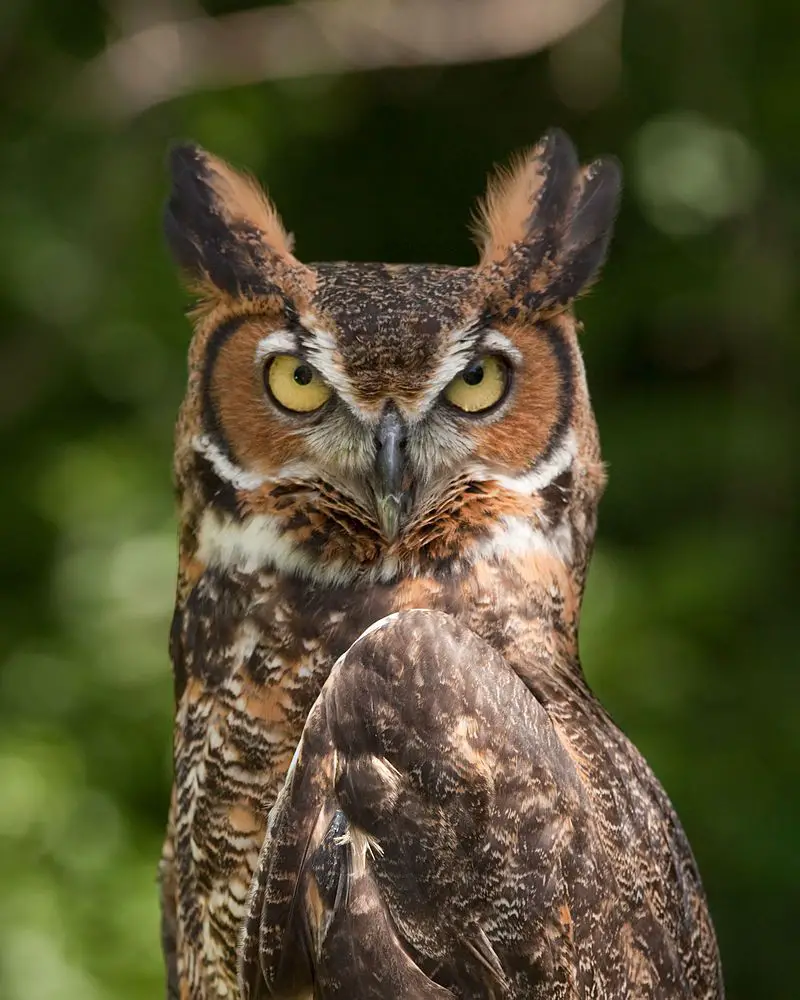
The great horned owl is a species of owl found in the Americas. It is also known by other names such as the tiger owl and the hoot owl.
This owl is known for its adaptability and can be found in various habitats across its wide range. Being a large owl, the great horned owl has a distinct appearance. It has prominent ear tufts on its head, which give it a horned appearance.
This characteristic distinguishes it from other owl species. One of the remarkable traits of the great horned owl is its adaptability. It can be found in a wide range of habitats, including forests, deserts, mountains, and even urban areas.
This versatility allows the owl to thrive in diverse environments and makes it the most widely distributed true owl in the Americas. The great horned owl is a skilled hunter, preying on a variety of animals. Its diet includes small mammals like rabbits, mice, and rats.
Additionally, it feeds on birds, reptiles, amphibians, and even other owls. This owl species has excellent hunting abilities. It possesses sharp talons and a powerful beak, which it uses to catch and kill its prey.
Its wings are designed for silent flight, allowing it to approach.
| Kingdom | Animalia |
| Phylum | Chordata |
| Class | Aves |
| Order | Strigiformes |
| Family | Strigidae |
| Genus | Bubo |
| Species | B. virginianus |
16. Ferruginous Hawk
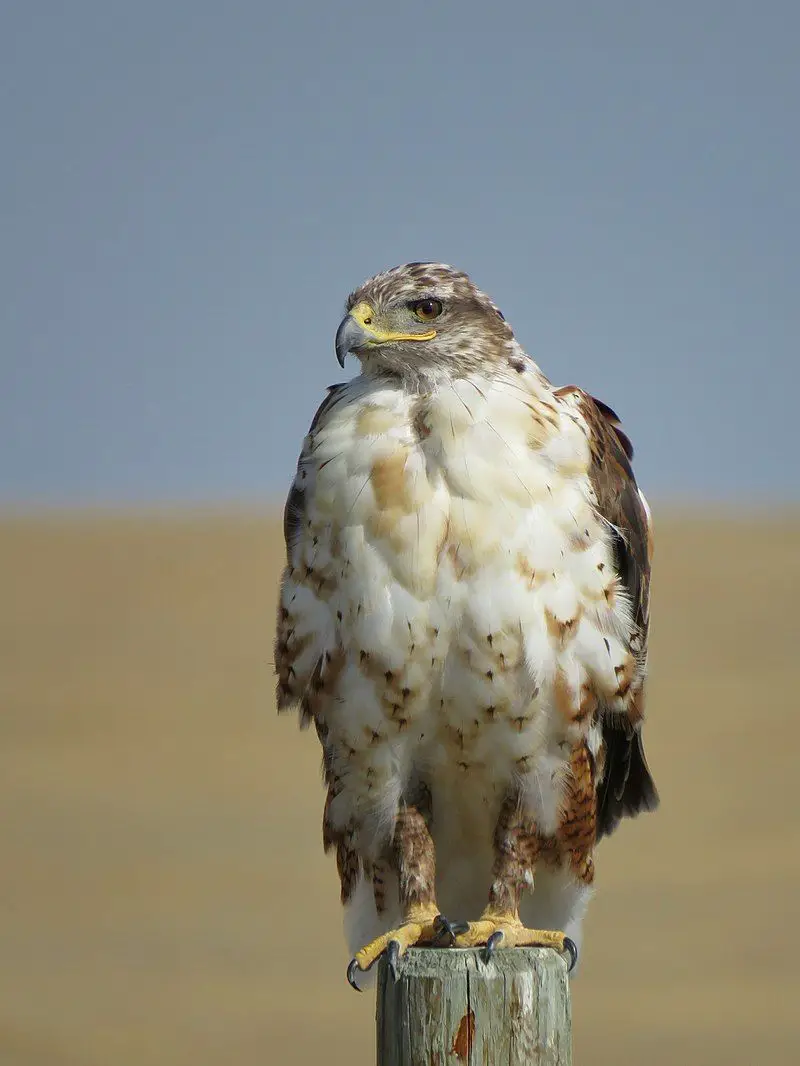
The paragraph introduces the ferruginous hawk, which is a type of large bird of prey. It is classified within the broad-winged buteo hawks group.
In the past, it was commonly referred to as the ferrugineous rough-leg because it resembled the rough-legged hawk, which is closely related to it.
The term “buteo” is the generic name given to this hawk, and it originates from the Latin word for “buzzard.” This suggests that the hawk may share some characteristics or behaviors with buzzards.
The Latin word “regalis” is used as the specific epithet for the ferruginous hawk, meaning “royal.” This term might have been chosen to emphasize its majestic appearance or regal qualities.
Overall, the paragraph provides information about the ferruginous hawk’s classification, its colloquial name, and the meanings behind its generic and specific names.
| Kingdom | Animalia |
| Phylum | Chordata |
| Class | Aves |
| Order | Accipitriformes |
| Family | Accipitridae |
| Genus | Buteo |
| Species | B. regalis |
17. Barred Owl
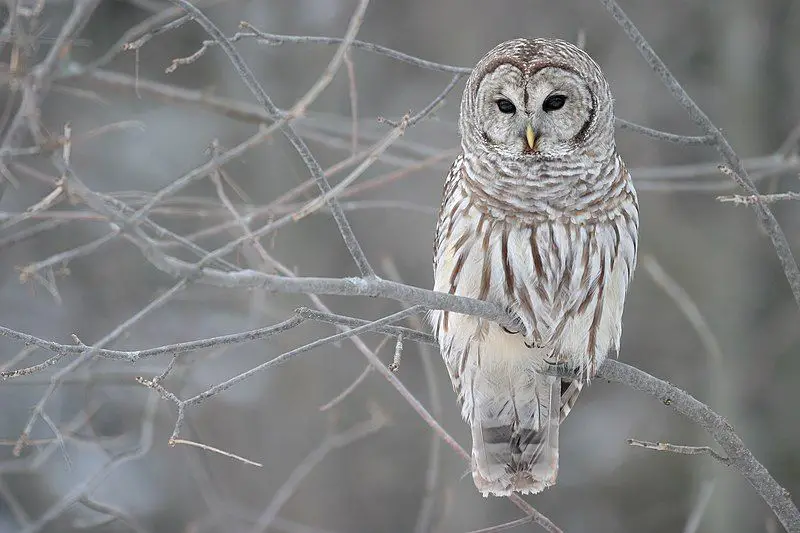
The barred owl is a type of owl that can be found in North America. It is sometimes called the northern barred owl, striped owl, hoot owl, or eight-hooter owl.
This owl is quite large compared to other owls. It belongs to a family of owls called Strigidae, which are known as true owls. The barred owl specifically belongs to the genus Strix.
The name of the family, Strigidae, actually comes from the genus Strix. Linnaean taxonomy is a system of naming and classifying organisms that was created by Carl Linnaeus, a Swedish botanist.
This system organizes living organisms into different categories based on their characteristics. The barred owl’s scientific name is Strix varia.In Linnaean taxonomy, the genus name comes first, followed by the species name.
So for the barred owl, Strix is the genus and varia is the species.
This helps scientists and researchers identify and study different species. The barred owl is known for its distinctive call, which sounds like “who-cooks-for-you, who-cooks-for-you-all.” This call is often heard at night, which is why it is sometimes referred to as a hoot owl.
| Kingdom | Animalia |
| Phylum | Chordata |
| Class | Aves |
| Order | Strigiformes |
| Family | Strigidae |
| Genus | Strix |
| Species | S. varia |
18. Northern Harrier

The northern harrier is a bird of prey that is commonly found in the northern parts of the northern hemisphere. It is also known by other names such as the marsh hawk or ring-tailed hawk.
This bird is known for its exceptional hunting skills and distinctive appearance. Breeding is a significant part of the northern harrier’s life cycle. It prefers to breed in the northern regions of Canada and the northernmost parts of the United States.
These areas provide suitable habitats for the bird’s nesting and breeding activities. The northern harrier’s habitat mainly consists of marshes, wetlands, and open fields.
These environments offer an abundance of prey, including small mammals and birds, which the harrier hunts for food.
Its hunting technique is unique as it relies on low, slow flight and uses its keen sense of hearing and sight to locate and capture its prey. One remarkable characteristic of the northern harrier is its distinctive appearance.
It has long, narrow wings that allow it to maneuver swiftly through the air. Its tail is also long and has a distinctive shape, resembling a ring.
This feature is why it is sometimes referred to as the ring-tailed hawk. The northern harrier is a medium-sized bird, with males usually being slightly smaller than females.
| Kingdom | Animalia |
| Phylum | Chordata |
| Class | Aves |
| Order | Accipitriformes |
| Family | Accipitridae |
| Genus | Circus |
| Species | C. hudsonius |
19. Eastern Screech Owl

The eastern screech owl, also known as the eastern screech-owl, is a type of small owl. It is commonly found in Eastern North America, spanning from Mexico up to Canada. This owl species is known for its small size, making it relatively easy to identify.
It is not particularly large like some other owl species. The eastern screech owl is considered to be a fairly common sight in its range, which covers a wide geographic area. Despite its name, the eastern screech owl does not only screech.
It has a variety of vocalizations, including whistles and trills. These sounds can be quite distinct and are often heard during the night.
This owl species is known for being vocal and can produce a range of different calls. The eastern screech owl is primarily nocturnal, meaning it is most active during the night.
It spends its days roosting in tree cavities or other hidden areas, using its excellent camouflage to blend in with its surroundings.
This owl’s plumage, or feathers, helps it remain well hidden and protected from predators during the daylight hours. This owl species has adapted well to living in various habitats, including forests, woodlands, and even.
| Kingdom | Animalia |
| Phylum | Chordata |
| Class | Aves |
| Order | Strigiformes |
| Family | Strigidae |
| Genus | Megascops |
| Species | M. asio |
20. Merlin

The merlin is a type of falcon that can be found in various parts of the Northern Hemisphere. It is known for its small size compared to other falcon species.
The merlin has several subspecies that exist in different regions of North America and Eurasia. These falcons are widely distributed across their habitat range and can be found in diverse environments. They can be seen in forests, grasslands, and even urban areas.
The ability of the merlin to adapt to various habitats contributes to its widespread presence. In North America, the merlin has different subspecies that are found in distinct regions.
For example, there is the prairie merlin, which is primarily found in the central grasslands of the continent. On the other hand, the taiga merlin inhabits the boreal forests of Canada and Alaska. In Eurasia, the merlin also has varied subspecies.
They can be found in different countries such as Russia, Norway, and Sweden, among others. Each subspecies may have specific adaptations and characteristics that suit their particular environment. The Merlin falcon is known for its agility and speed.
It is a skilled hunter, capable of catching swift-flying prey such as small birds and insects.
| Kingdom | Animalia |
| Phylum | Chordata |
| Class | Aves |
| Order | Falconiformes |
| Family | Falconidae |
| Genus | Falco |
| Species | F. columbarius |
21. Snowy Owl
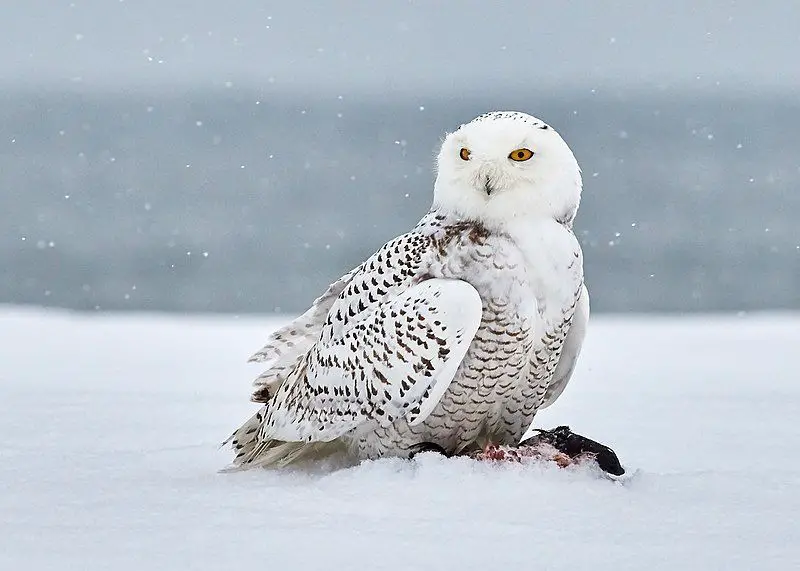
The snowy owl is a type of owl that is also known by other names such as the polar owl, the white owl, and the Arctic owl. It belongs to the true owl family and is characterized by its large size and white feathers.
These owls can be found in both North America and the Palearctic regions, specifically in the Arctic areas. Snowy owls are well adapted to their harsh Arctic environments.
They have evolved to blend in with the snowy landscapes, which helps them remain camouflaged and hidden from predators.
Their white feathers act as a protective cover, allowing them to hunt and survive in their habitat. One interesting fact about snowy owls is that they are predominantly found in the tundra regions.
The tundra is a cold and treeless biome that is characterized by low temperatures and short summers. This environment provides ideal conditions for the snowy owl’s breeding. During the breeding season, snowy owls build their nests on the ground.
They use the tundra’s vegetation and materials like feathers and moss to construct their nests. This nesting behavior is unique among owls, as most other owl species prefer to nest in trees. Snowy owls feed primarily on small mammals, such as lemmings, voles.
| Kingdom | Animalia |
| Phylum | Chordata |
| Class | Aves |
| Order | Strigiformes |
| Family | Strigidae |
| Genus | Bubo |
| Species | B. scandiacus |
22. Northern saw-whet Owl
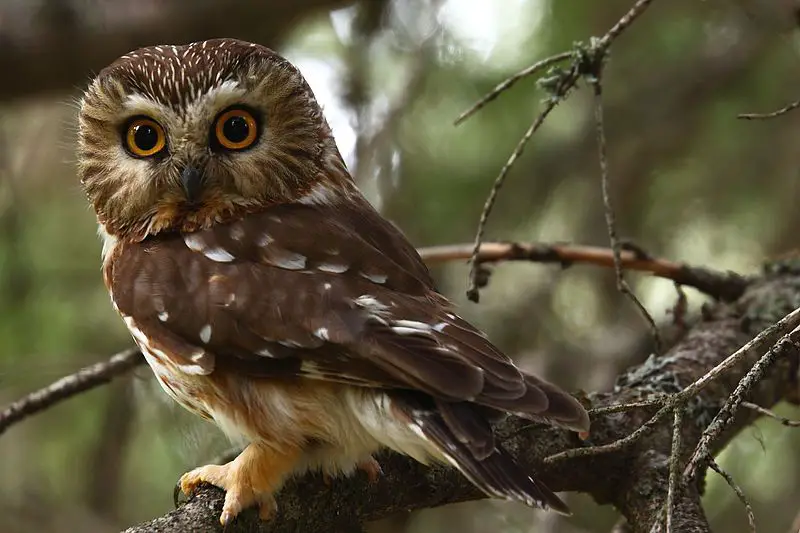
The northern saw-whet owl belongs to the family Strigidae and is a small species of owl. It is originally from North America. This type of owl is part of the genus Aegolius and is known for being one of the smallest owl species in North America.
They are commonly found in dense thickets, where they tend to stay at eye level, making them easier to spot. However, they can also be observed perched up to about 20 feet above the ground.
The northern saw-whet owl is well-adapted to its habitat, which includes forests and woodlands. They have excellent camouflage skills, blending in with the surrounding trees and vegetation.
These owls are mainly active during the night, using their keen eyesight and hearing to hunt for prey. Their diet mainly consists of small mammals, such as mice and voles. Despite their small size, saw-whet owls have a distinctive call.
Their vocalizations are often described as a repetitive, high-pitched tooting sound, similar to the noise made by a saw being sharpened. Breeding season for these owls typically occurs during the spring. The female lays a clutch of eggs in a tree cavity or abandoned.
| Kingdom | Animalia |
| Phylum | Chordata |
| Class | Aves |
| Order | Strigiformes |
| Family | Strigidae |
| Genus | Aegolius |
| Species | A. acadicus |
23. Owl
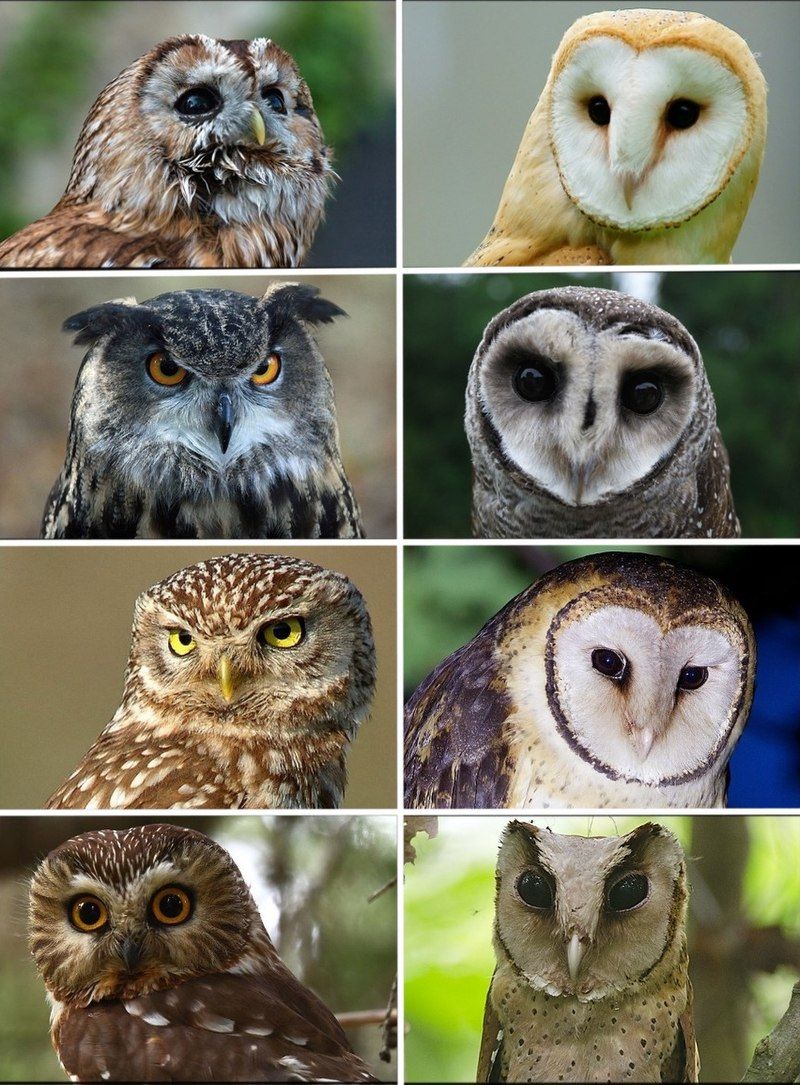
Owls are a type of bird, and they belong to the order Strigiformes. This order includes more than 200 species of birds. Most owls are solitary, meaning they prefer to live alone.
They are also nocturnal, which means they are active during the night. One characteristic of owls is their upright stance. Unlike other birds that often perch horizontally, owls tend to stand vertically.
This upright posture helps them have a better view of their surroundings. Owls have a large and broad head. This feature allows them to have a big brain and excellent eyesight. Their eyes are positioned in the front of their face, which gives them binocular vision.
This means they can see things with depth perception, similar to humans. In addition to their eyesight, owls also have binaural hearing. This means they can hear sounds from both ears independently. Their ears are located on the sides of their head and are asymmetrical.
This allows them to locate the source of sounds accurately. Owls are known for their sharp talons, which are their claws. These talons are used for catching and grasping their prey. Owls have a strong grip, allowing them to hold onto their prey tightly.
| Kingdom | Animalia |
| Phylum | Chordata |
| Class | Aves |
| Clade | Telluraves |
| Order | Strigiformes |
24. Turkey Vulture
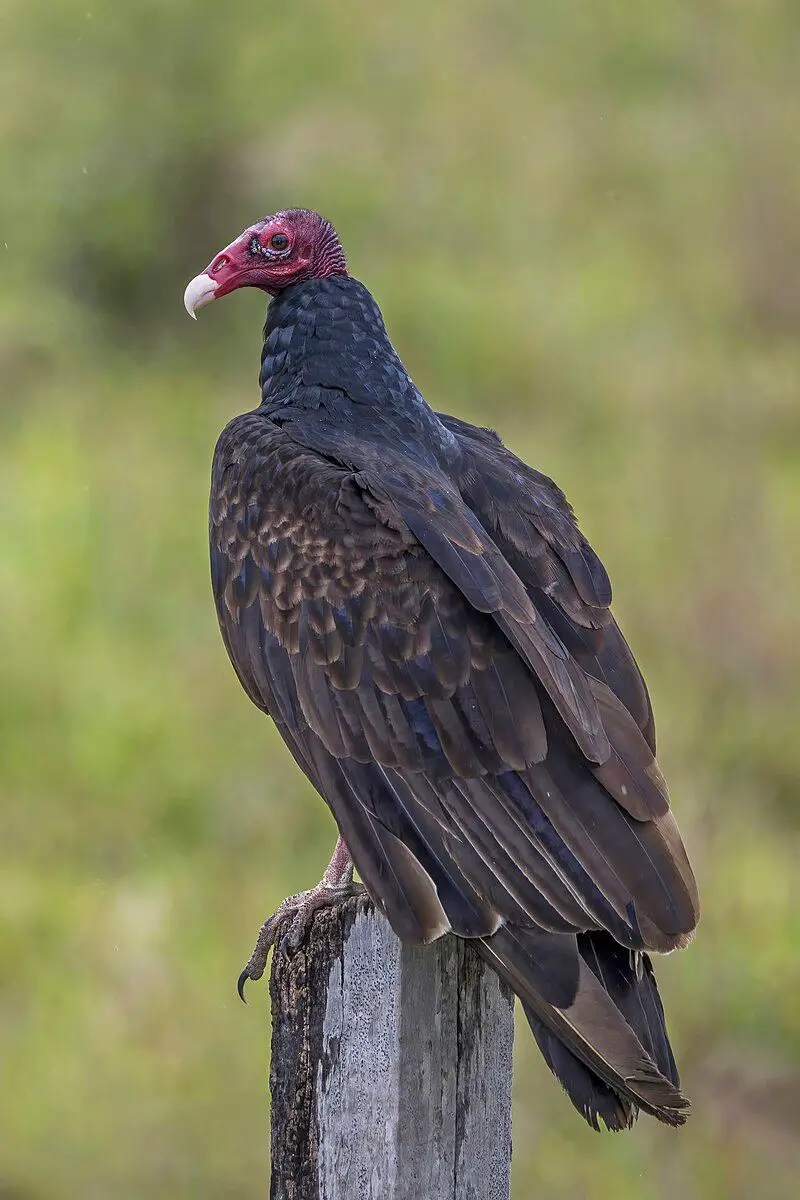
The turkey vulture is a type of vulture that can be found in many different parts of the Americas. It is the most widespread of all the New World vultures. There are three species of vultures in a group called the genus Cathartes.
The turkey vulture is one of these species. It belongs to the family Cathartidae, which is a group of birds that includes vultures. The turkey vulture can be found in a vast range of locations.
It can be seen from southern Canada, all the way down to the very tip of South America. This means that it can be found in many different countries and environments throughout the Americas. This bird has a very large range because it is well adapted to various habitats.
It can thrive in a wide range of conditions and climates. The turkey vulture is known for its characteristic appearance. It has a bald head, which is red. Its body is mostly black or dark brown, and it has long wings and a long tail.
This vulture is a scavenger, which means that it feeds on dead animals. It has a highly developed sense of smell, which allows it to locate carrion from high.
| Kingdom | Animalia |
| Phylum | Chordata |
| Class | Aves |
| Order | Accipitriformes |
| Family | Cathartidae |
| Genus | Cathartes |
| Species | C. aura |
Conclusion
In conclusion, birds of prey play a crucial role in maintaining the balance of Illinois’ ecosystems. Through their hunting abilities and feeding habits, they help control populations of small mammals and birds, contributing to the overall health of the environment.
Despite facing various threats and challenges, many bird of prey species have managed to adapt and survive in Illinois.
Efforts to protect and conserve their habitats, as well as educate the public about their importance, are needed to ensure these magnificent birds continue to thrive in the state’s diverse landscapes.
By recognizing and appreciating the significance of birds of prey, we can contribute to the preservation of Illinois’ natural heritage for future generations.